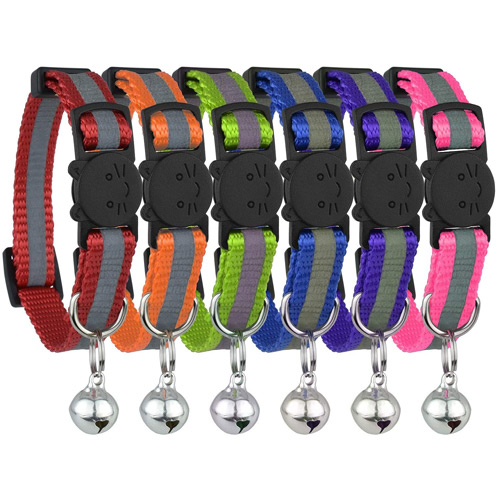
There are differing opinions about whether it’s more humane to keep your cat safely indoors (which can limit their natural behavior and opportunity for enrichment) or give them outdoor access to do “cat things" more freely (even though it can be dangerous).
Regardless of where you land on this topic, we can all agree that keeping our cats safe is vitally important.
That’s why we’re talking about ways you can increase your cat’s safety if they’re outdoors after dark.
Skip to section:
Is it Safe for Cats to Be Outside at Night?
There are definitely dangers outside, especially after dark. That may be when cats are more active, hunting their evening prey. But remember, cats are prey too. They can be hunted by other animals, like coyotes, mountain lions, and even large birds of prey.
Lower visibility is also a factor with cars. Even indoors, a black cat can vanish into a shadow. I can’t tell you how many conversations I’ve had with a dark piece of clothing in the corner that I thought was my cat, Ollie. If he were outside in the dark, only his eyes would be visible. That’s a scary situation with a busy street nearby.

In cooler climates, overnight temperatures can also be a safety issue. Cats may have fur coats, but most aren’t designed for extreme cold temps.
These are just some of the nighttime dangers that our cats face. In my opinion, it’s best to bring housecats inside overnight. But not all cats are comfortable inside. Barn cats, strays, or fearful cats may prefer to be outside. That’s where you can really help by trying some of our tips.
How to Make It Safer for Outdoor Cats
Break-away Collars Are a Must!
Any collar you put on your cat should have a break-away latch. Cats tend to squeeze into tight spaces or climb things like fences and trees.
They can easily snag their collar and strangle themselves trying to get away. A break-away latch can help ensure that the collar will pop off rather than harm your cat.
GoTags makes a reflective, break-away collar with custom identification information stitched right into the material.
Reflective Cat Collars for Better Nighttime Visibility
With dogs, you should use an LED collar on them for walks in the dark, but that won’t work with all cats. LED collars have to be manually turned on, meaning you’d have to see your cat before it gets dark to turn on their collar.
However, there are other collar options that will help your cat stand out better to drivers at night if you really can’t bring in your cat at night. Look for one that includes a wide band of highly reflective material that you can be sure will reflect the light.
If the collar has a bell, realize that they can get caught up on wires and branches too, so you may want to remove it. If the bell does get caught, the collar should break away and you'll be relying on their microchip should they go missing.
You may also find “glow-in-the-dark” collars, which can be OK for nighttime visibility when they’ve been “charged.” But they aren’t always dependable, as the “glow” needs to charge in the light for several hours, and even then it can deplete rather quickly.
Make Sure Your Cat Is Microchipped
The benefits of a break-away collar are clear. But that safety feature means you can’t rely on the collar for your cat’s ID and your contact info. You’ll need to have a backup source of ID in case their collar comes off, along with all of their identifying information.
It’s always a good idea to have your cat microchipped — whether they’re indoor or outdoor.
This is a simple and inexpensive procedure your veterinarian can perform by injecting a tiny microchip (about the size of a grain of rice) under your cat’s skin. It can be read with a scanner and provide complete contact information in case your cat is found or picked up by animal control services or a good samaritan if your cat is injured.
Here’s a detailed overview of how to keep your cat’s microchip up to date.
Use GPS Trackers
There are lots of pet trackers you can attach to collars these days. You can even use an airtag collar or add an airtag to their existing collar. While they won’t help keep your cat safe in the moment, they can tell you where your cat is spending their time. If it’s too far from home or in a highly dangerous area (like the neighbor’s yard with lots of dogs, a location known for using rat baits, or a green belt where the coyotes hang out) you can reconsider allowing your cat out at night. And you’ll have a better chance of finding them if they don’t come home or they get into trouble.
Install Cat-proof Fencing
This can be a pricey option that’s only available to those who own their homes and can make changes to the fence structure. It also requires a secure fence line with no holes your cat can squeeze through. It’s still good to know these products exist. While you can’t guarantee your cat will be 100% safe in your yard at night, it’s still better than roaming freely.
There are a few different styles. They attach to the top of the fence to keep cats from climbing over.
The roller style does just that. If your cat tries to stand on it, it gently rolls them off. It is added to existing fences or wall structures.
The overhang style is simply an overhang on your side of the fence that your cat won’t be able to navigate.
There are kits and DIY options out there. Just be careful. There’s the potential for injury if these are done incorrectly. For something like this, I would defer to the experts.
And, of course, our Preventive Vet team will never recommend or support anything that’s intended to cause pain or fear. Avoid the use of spikes, electric shock, etc. as a tool to keep your cat secure. The stress it causes to your cat (and other animals) can outweigh the benefits in most cases.
Set Up Safe Outdoor Spaces
Whether you have an indoor/outdoor cat, a fully outdoor cat, or strays in the area, it’s extremely helpful to offer a couple of warm and safe nighttime hideouts. This is especially important during cold weather and can provide extra safety from predators.
There are lots of options:
You can buy heated enclosures like this heated cat house for outside.
There are unheated options like this outdoor feral cat house for multiple cats.
It’s easy and inexpensive to make your own outdoor cold-weather enclosure. Here are a couple of great videos:
Another great option for your indoor cat is a catio! They let your cat experience the sights, sounds, and smells of the outdoors while staying protected.
They range from simple DIY versions you can pop on the patio (think big chicken coop) to framed and screened additions to your home that they access through a cat door, and everything in between. Here’s a great source for DIY catio plans if you want to build your own.
Should You Put Warm or Reflective Clothes on Your Cat?
That’s a great big no! At first glance, it might seem like a good idea to put a brightly colored sweater or shirt on your cat. But they pose a serious risk.
Just like collars, anything you put around your cat’s body can get caught on tree or shrub branches, a loose nail, etc., and lead to strangulation or severe injury. Better to bring your cat in at night or, if they can’t come in, provide warm, safe spaces as opposed to using cat clothing.

Teach Your Cat to Come in at Night
How great would it be if your cat just knew to come inside at a certain time each night? It’s not as hard as you might think to make that happen. You just have to give them a good reason.
-
Find a treat or special food that your cat absolutely LOVES. The only time they’re going to get it is when they come inside at night.
-
To start, you may need to go out and call them. When they step inside the door, they get their special treat.
-
If they don’t come when called, but you know where they are, you can go to them. Either get them to follow you inside before giving the treat or gradually (over many days) get them to move a bit closer to the door before they get their treat. Work up to them coming all the way inside for the treat.
-
If you do this at the same time each night, for a while, your cat will learn when they should head inside for that super special treat.
-
You can make coming inside even more rewarding by giving lots of verbal praise, pets, and even a good play session.
Remember, the reward for coming inside has to be more appealing than the experience of staying outside.

Wondering what your cat is doing out there at night? We've got a fun article all about nighttime cat behavior. You'll be surprised to learn how far they might be roaming.





